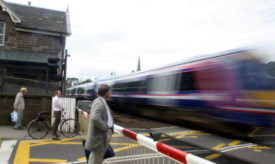The Gray Street level crossing in Broughty Ferry is the most dangerous in Scotland, according to new figures from British Transport Police.
Some 214 drivers and pedestrians have been prosecuted in the past five years after dicing with death where the Dundee-Aberdeen railway line crosses the busy street.
BTP said Cleghorn crossing in South Lanarkshire was the second with 205 prosecutions. Third was Garve crossing, near Easter Ross, with 137 prosecutions.
The force revealed there had been a total of 1,864 prosecutions across the country since 2009 and 660 known “incidents”.
Drivers were hit with £60 fines and three points on their licence. Pedestrians who go on the tracks face fines of up to £1,000 and a criminal record.
Laurie Bidwell, Labour councillor for Broughty Ferry, said he was “alarmed” by the figures.
He said: “I understand that most of these offences have arisen because drivers and pedestrians have been ignoring the flashing warning lights and dodging the barriers.
“This is reckless and endangers life and limb of the pedestrians and drivers involved and, of course, rail passengers, railway staff as well as other road users.”
One local, who admitted to running the crossing, blamed the barriers themselves.
“The barriers are just so slow,” said the resident. “It seems like they come down way too early before the train has passed and take ages to go back up.
“The crossing is on one of the main roads in the centre of Broughty Ferry and because of the one-way system the traffic gets so backed up. When people see the barriers starting to come down they do race through so they don’t have to be stuck in a queue for 10 minutes.”
Tory transport spokesman Alex Johnstone MSP said: “Worse than putting their own lives in jeopardy, these individuals are putting train drivers and passengers at risk.
“We need to ensure the full force of the law is used to punish those caught deliberately misusing level crossings so that people are sent the strong message that it is not worth the risk.”
Sandy Allan, road safety manager for the Royal Society for the Prevention of Accidents, said: “Misuse of level crossings by drivers is, and should be, treated seriously because it can so easily cause a catastrophic accident, resulting in multiple fatalities.”
A spokesman for British Transport Police said they are working closely with all rail industry partners to educate individuals on the proper use of crossings.
He said: “However, we acknowledge level crossing misuse remains an issue.
“Anyone flouting the law and safety puts their life, and the lives of others at real risk and BTP will ensure those who continue to misuse level crossings are prosecuted.”
